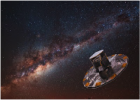You are here
ESA’s Gaia mission to survey a billion stars launched today

On December 19th at 10:12 (Italian time) the mission GAIA of the European Space Agency takes off, with the launch of the satellite from the European base in Kourou (French Guiana) with the Soyuz - Fregat.
The purpose of the mission is ambitious: to produce a three-dimensional map of our Galaxy, revolutionizing data with unprecedented mosaic of information about the processes that have characterized the formation and evolution. In the 5 years mission, Gaia will study more than one billion objects in the Milky Way, providing measurements of positions, distances and motions (astrometry), intensity of the emitted radiation (photometry), and the characteristics of the radiation emitted at various lengths ' wavelengths (spectroscopy).
But Gaia will go even further, deepening the knowledge of the population of asteroids and, therefore, the origins of our solar system, searching for the presence of planets orbiting other stars and studying brown dwarfs and other astrophysical phenomena such as supernovae and quasars.
Cineca collaborates in mission GAIA both for the optimization of parallel software aimed at the reduction of the data to the catalog of the mission, and by providing the computational resources required on the system Fermi Blue Gene / Q, and data storage.
The collaboration on the software side consists in the implementation of a parallel version, optimized for FERMI of a module of the verification process that realizes, starting from the telemetry of the satellite, the reconstruction of the Celestial Sphere that produces the astro-metric catalog, and affects a subset of stars, called primary, namely up to about 50-100 millions of the billion of objects measured on the focal plane of the satellite.
On December 19 the National Institute for Astrophysics (INAF), in collaboration with ASI and ALTEC, organizes an event at he INAF-Astrophysical Observatory of Turin, for following live the launch of the satellite. Event live streaming on Media INAF.
Look below the launch (in Italian):
